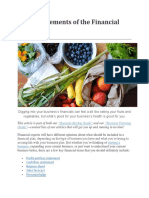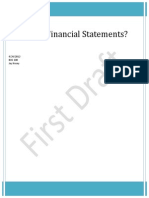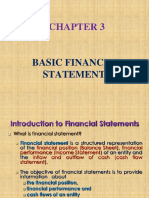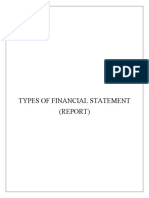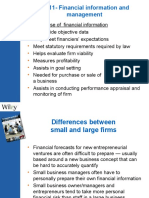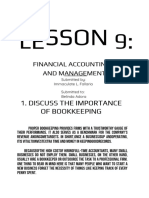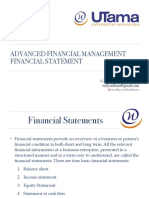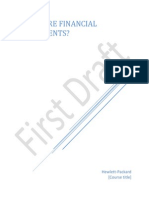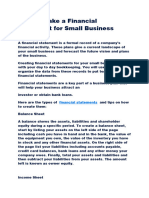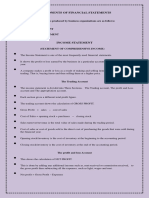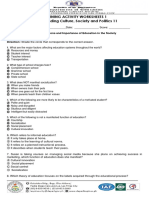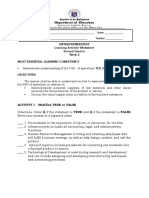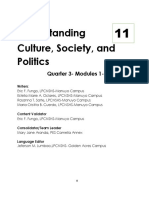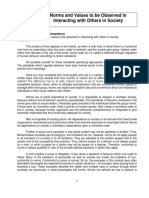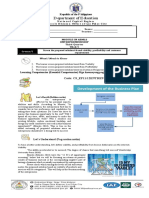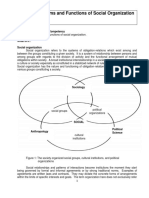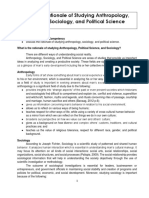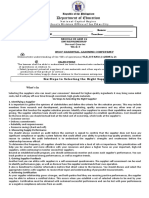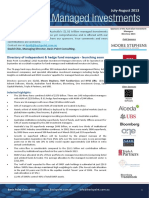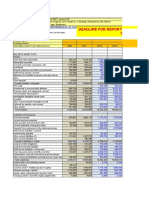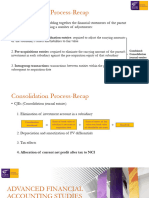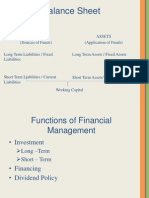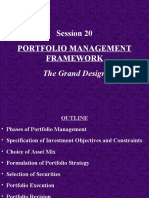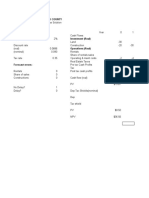MODULE IN ABM 12
ENTREPRENEURSP
Second Quarter
Week 8
MOST ESSENTIAL LEARNING COMPETENCY
The learner demonstrates understanding of concepts, underlying principles, and processes of starting and
operating a simple business. CS_EP11/12BENTREPIVa-i-4
OBJECTIVES
The learner shall be able to prepare:
Identify where there is a profit or loss for a business;
Generate an overall report on the activity.
INCOME STATEMENT, BALANCE SHEETS, CASH FLOW
What’s In
Financial Statements are the backbone of the business (Tern 1993); show how your business has been
performing and how you think it will perform over time. They are historical and show the business has been
operating (i.e., in terms of profitability, cash flow, assets, and liabilities, etc.).
Financial Forecasts projects a financial situation the business owner should be aiming for.
Importance of Financial Statements
• Reference tools to help guide business planning;
• Key documents for attracting funding (Investors and creditors will use them to assess the
soundness of the company’s finances);
Balance Sheet – a summary statement of a company’s financial position at a given point in time. (A balance
sheet measures what the company owns and subtracts what it owes) The central equation of a balance sheet
is:
Assets = Liabilities + Owner’s Equity
Assets include everything the company owns, such as cash, inventory, buildings, equipment, and
vehicles.
Liabilities include everything the company owes to others, such as vendor bills, credit card balances,
and bank loans.
Equity includes the claims owners have on the assets based on their portions of ownership in the
company.
� Two Forms of Balance Sheet
1. Account Form - it is a balance sheet like a T - Account listing assets on the debit side and equity and
liabilities on the right side. (Table 1.1)
Report Form - lists assets followed by liabilities and equity in vertical format.
�Profit and Loss Statement is a summary of the financial performance of a business over time (monthly,
quarterly, or annually is most common). Also known as the Income Statement. It is the list of the company’s
income and then subtracts all of its expenses. The resulting amount left at the bottom is the profit (or loss) that
the company experienced. Refer to the example below:
Profit = Revenues earned – Expenses incurred. If income exceeds business expenses, the business will have
effectively made a profit. On the other hand, if expenses exceed income, a loss would have been made. A profit
and loss statement is a great tool for identifying items of high expenditure or expenses they were unproductive
in producing profit. By analysing the profit and loss statement the entrepreneur can better control business
expenditure and, thereby, potentially increase profits.
Cash Flow refers to generating or producing cash (cash inflows) and using or consuming cash (cash outflows).
Think of cash flow as the lifeblood of the business, and keep that blood circulating at all times in order to avoid
failure.
Cash flows in the statement are divided into the following three areas:
• Operating activities. These constitute the revenue generating activities of a business. Examples of
operating activities are cash received and disbursed for product sales, royalties, commissions, fines,
lawsuits, supplier and lender invoices, and payroll.
• Investing activities. These constitutes payments made to acquire long term assets, as well as cash
received from their sale. Examples of investing activities are the purchase of fixed assets and the
purchase or sale of securities issued by other entities.
• Financing activities. These constitutes activities that will alter the equity or borrowings of a business.
Examples are the sale of company shares, the repurchase of shares, and dividend payments.
Two Methods Presenting Statement of Cash Flows Direct Method requires to present cash flow information
that is directly associated with the items triggering cash flows. Refer to the given example.
Indirect Method approach begins with the net income or loss reported on the company’s income statement,
and then makes a series of adjustments to this figure to arrive at the amount of net cash provided by the
operating activities.
�Reference: ENTREPRENEURSHIP by Divina M. Edralin © 2019







